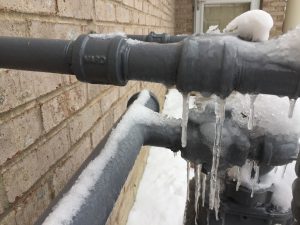Protecting Against Frozen Pipes in Cold Weather: Key Advice
Protecting Against Frozen Pipes in Cold Weather: Key Advice
Blog Article
We've encountered this article on How to prepare your home plumbing for winter weather listed below on the internet and figured it made perfect sense to write about it with you on my blog.

Winter can ruin your pipes, specifically by freezing pipes. Right here's just how to stop it from happening and what to do if it does.
Introduction
As temperatures drop, the risk of frozen pipes increases, potentially resulting in expensive repair work and water damage. Comprehending just how to avoid icy pipes is crucial for home owners in chilly environments.
Prevention Tips
Shielding vulnerable pipelines
Wrap pipes in insulation sleeves or make use of heat tape to shield them from freezing temperature levels. Focus on pipelines in unheated or outside locations of the home.
Home heating methods
Keep interior spaces sufficiently heated up, particularly areas with plumbing. Open up closet doors to permit cozy air to distribute around pipes under sinks.
How to recognize icy pipes
Look for lowered water circulation from faucets, unusual smells or noises from pipes, and noticeable frost on subjected pipes.
Long-Term Solutions
Architectural modifications
Consider rerouting pipelines away from outside walls or unheated locations. Add extra insulation to attic rooms, basements, and crawl spaces.
Updating insulation
Invest in top quality insulation for pipelines, attics, and wall surfaces. Proper insulation helps keep consistent temperatures and lowers the danger of icy pipes.
Shielding Exterior Pipes
Yard pipes and outside faucets
Disconnect and drain pipes garden hoses prior to wintertime. Set up frost-proof faucets or cover outside faucets with shielded caps.
Recognizing Frozen Pipelines
What triggers pipelines to freeze?
Pipes ice up when exposed to temperature levels below 32 ° F (0 ° C) for expanded periods. As water inside the pipes ices up, it expands, taxing the pipeline walls and possibly creating them to burst.
Dangers and problems
Frozen pipes can cause water supply interruptions, residential or commercial property damage, and pricey fixings. Ruptured pipes can flooding homes and create substantial architectural damages.
Indicators of Frozen Pipes
Determining frozen pipes early can avoid them from breaking.
What to Do If Your Pipelines Freeze
Immediate activities to take
If you suspect icy pipes, keep faucets open up to alleviate stress as the ice thaws. Utilize a hairdryer or towels soaked in warm water to thaw pipelines slowly.
Final thought
Stopping frozen pipes calls for positive procedures and fast responses. By recognizing the causes, indicators, and preventive measures, home owners can secure their pipes during cold weather.
5 Ways to Prevent Frozen Pipes
Drain Outdoor Faucets and Disconnect Hoses
First, close the shut-off valve that controls the flow of water in the pipe to your outdoor faucet. Then, head outside to disconnect and drain your hose and open the outdoor faucet to allow the water to completely drain out of the line. Turn off the faucet when done. Finally, head back to the shut-off valve and drain the remaining water inside the pipe into a bucket or container. Additionally, if you have a home irrigation system, you should consider hiring an expert to clear the system of water each year.
Insulate Pipes
One of the best and most cost-effective methods for preventing frozen water pipes is to wrap your pipes with insulation. This is especially important for areas in your home that aren’t exposed to heat, such as an attic. We suggest using foam sleeves, which can typically be found at your local hardware store.
Keep Heat Running at 65
Your pipes are located inside your walls, and the temperature there is much colder than the rest of the house. To prevent your pipes from freezing, The Insurance Information Institute suggests that you keep your home heated to at least 65 degrees, even when traveling. You may want to invest in smart devices that can keep an eye on the temperature in your home while you’re away.
Leave Water Dripping
Moving water — even a small trickle — can prevent ice from forming inside your pipes. When freezing temps are imminent, start a drip of water from all faucets that serve exposed pipes. Leaving a few faucets running will also help relieve pressure inside the pipes and help prevent a rupture if the water inside freezes.
Open Cupboard Doors
Warm your kitchen and bathroom pipes by opening cupboards and vanities. You should also leave your interior doors ajar to help warm air circulate evenly throughout your home.

As a reader about Winter Plumbing Precautions: Preventing Frozen Pipes, I figured sharing that post was essential. Loved our blog? Please quickly share it. Let another person check it out. I praise you for your time. Please check up our website back soon.
Click Here Report this page